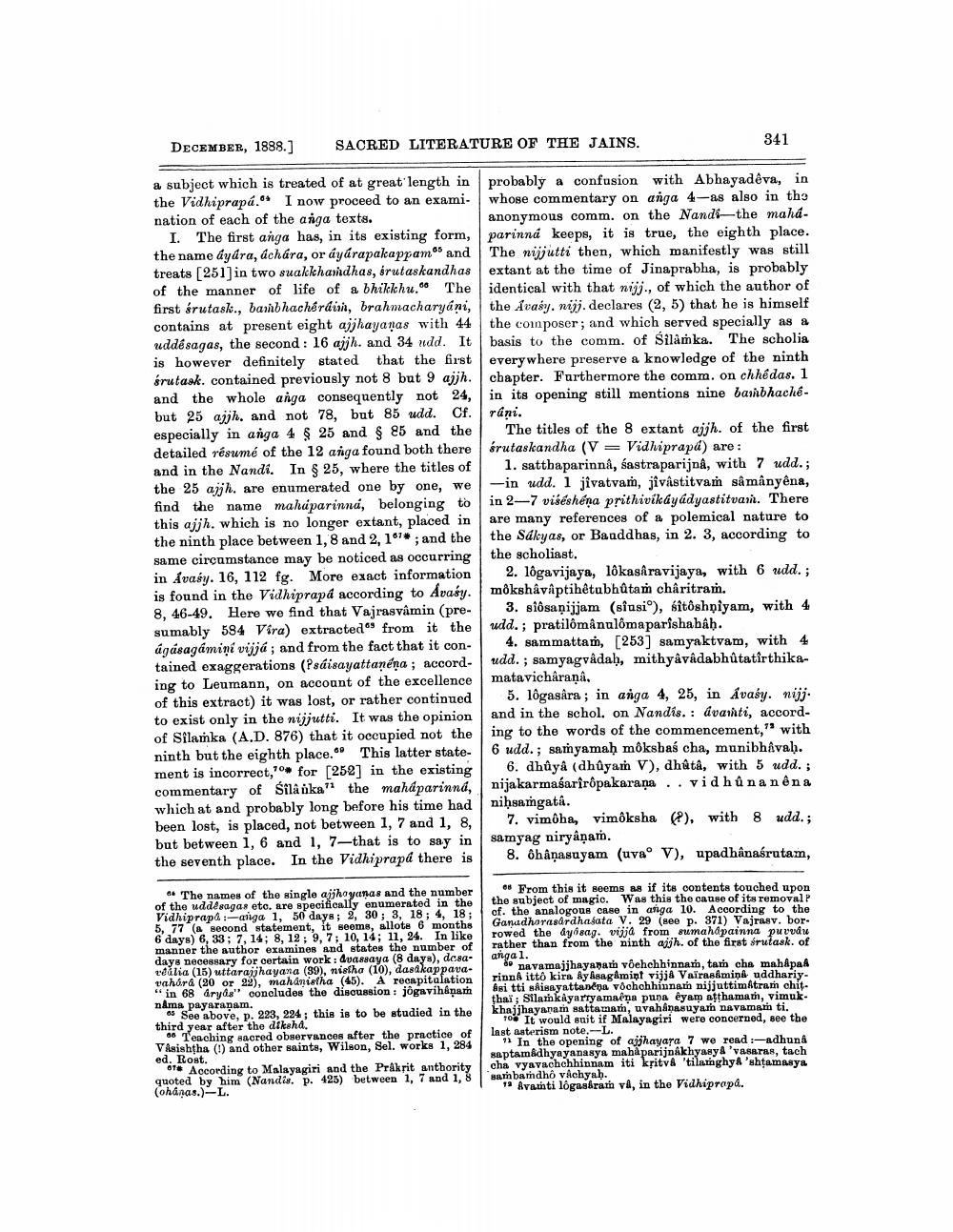________________
SACRED LITERATURE OF THE JAINS.
DECEMBER, 1888.]
a subject which is treated of at great length in the Vidhiprapa. I now proceed to an examination of each of the anga texts.
I. The first anga has, in its existing form, the name áyára, áchára, or áyárapakappams and treats [251] in two suakkhamdhas, śrutaskandhas of the manner of life of a bhikkhu." The first śrutask., bambhachéráin, brahmacharyani, contains at present eight ajjhayanas with 44 uddésagas, the second: 16 ajjh. and 34 udd. It is however definitely stated that the first śrutask. contained previously not 8 but 9 ajjh. and the whole anga consequently not 24, but 25 ajjh. and not 78, but 85 udd. Cf. especially in anga 4 § 25 and § 85 and the detailed résumé of the 12 anga found both there and in the Nandi. In § 25, where the titles of the 25 ajjh. are enumerated one by one, we find the name mahaparinná, belonging to this ajjh. which is no longer extant, placed in the ninth place between 1, 8 and 2, 161*; and the same circumstance may be noticed as occurring in Avasy. 16, 112 fg. More exact information is found in the Vidhiprapa according to Avasy. 8, 46-49. Here we find that Vajrasvamin (presumably 584 Vira) extracted from it the ágásagámini vijjá; and from the fact that it contained exaggerations (Psáisayattanena; according to Leumann, on account of the excellence of this extract) it was lost, or rather continued to exist only in the nijjutti. It was the opinion of Silamka (A.D. 876) that it occupied not the ninth but the eighth place." This latter statement is incorrect,70% for [252] in the existing commentary of Silâüka" the maháparinná, which at and probably long before his time had been lost, is placed, not between 1, 7 and 1, 8, but between 1, 6 and 1, 7-that is to say in the seventh place. In the Vidhiprapa there is
The names of the single ajjhayanas and the number of the uddesagas etc. are specifically enumerated in the Vidhiprapa:-aiga 1, 50 days; 2, 30; 3, 18; 4, 18; 5, 77 (a second statement, it seems, allots 6 months 6 days) 6, 33; 7, 14; 8, 12; 9, 7; 10, 14; 11, 24. In like manner the author examines and states the number of days necessary for certain work: Avassaya (8 days), desaréalia (15) uttarajjhayana (39), nistha (10), dasakappavavahára (20 or 22), mahánistha (45). A recapitulation "in 68 aryas" concludes the discussion: jogavihanam nama payaranam.
65 See above, p. 223, 224; this is to be studied in the third year after the diksha.
se Teaching sacred observances after the practice of Vasishtha (1) and other saints, Wilson, Sel. works 1, 284 ed. Rost.
67 According to Malayagiri and the Prakrit anthority quoted by him (Nandis. p. 425) between 1, 7 and 1, 8 (ohánas.)-L.
341
probably a confusion with Abhayadeva, in whose commentary on anga 4-as also in the anonymous comm. on the Nandi-the maháparinná keeps, it is true, the eighth place. The nijjutti then, which manifestly was still extant at the time of Jinaprabha, is probably identical with that nijj., of which the author of the Avasy, nijj. declares (2, 5) that he is himself the composer; and which served specially as a basis to the comm. of Silamka. The scholia everywhere preserve a knowledge of the ninth chapter. Furthermore the comm. on chhedas. 1 in its opening still mentions nine banbhachéráni.
The titles of the 8 extant ajjh. of the first érutaskandha (V = Vidhiprapd) are:
1. satthaparinnâ, sastraparijnâ, with 7 udd.; -in udd. 1 jîvatvam, jîvâstitvam sâmânyêna, in 2-7 viséshéna prithivikáyádyastitvam. There are many references of a polemical nature to the Sakyas, or Bauddhas, in 2. 3, according to the scholiast.
2. lôgavijaya, lôkasâravijaya, with 6 udd.; môkshâvâptihêtubhûtam châritram.
3. siôsanijjam (siusi°), sitôshpiyam, with 4 udd.; pratilômânulomaparishahâb.
4. sammattam, [253] samyaktvam, with 4 udd.; samyagvådaḥ, mithyâvâdabhûtatîrthikamatavicharanâ.
5. lôgasâra; in anga 4, 25, in Avasy. nijj. and in the schol. on Nandis.: avanti, according to the words of the commencement," with 6 udd.; samyamaḥ môkshaś cha, munibhavaḥ. 6. dhûya (dhûyam V), dhûtâ, with 5 udd.; nijakarmaśarîrôpakarana.. vid hûnanêna
niḥsamgatâ.
7. vimôha, vimôksha (?), with 8 udd.; samyag niryâņam.
8. ôhânasuyam (uva V), upadhânaśrutam,
es From this it seems as if its contents touched upon the subject of magic. Was this the cause of its removal? cf. the analogous case in anga 10. According to the Ganadhorasardhasata V. 29 (see p. 371) Vajrasv. borrowed the dysag. vijja from sumah@painna puvvâu rather than from the ninth ajjh. of the first śrutask. of angal.
navamajjhayanam vôehchhinnam, tam cha mahapa rinna ittô kira Ayasagamint vijjå Vairasamina uddhariyAsi tti sAisayattančna vochchhinnam nijjuttimâtram chitthai; Silahkayarryamana puna êyam atthamam, vimukkhajjhayanam sattamam, uvahanasuyam navamaṁ ti.
70 It would suit if Malayagiri were concerned, see the last asterism note.-L.
In the opening of ajjhayara 7 we read-adhunâ saptamadhyayanasya mahaparijnakhyasya 'vasaras, tach cha vyavachchhinnam iti kritvå tilamghya 'shṭamasya sambamdhô vâchyab.
13 Avamti lôgasáram vâ, in the Vidhiprapa.




